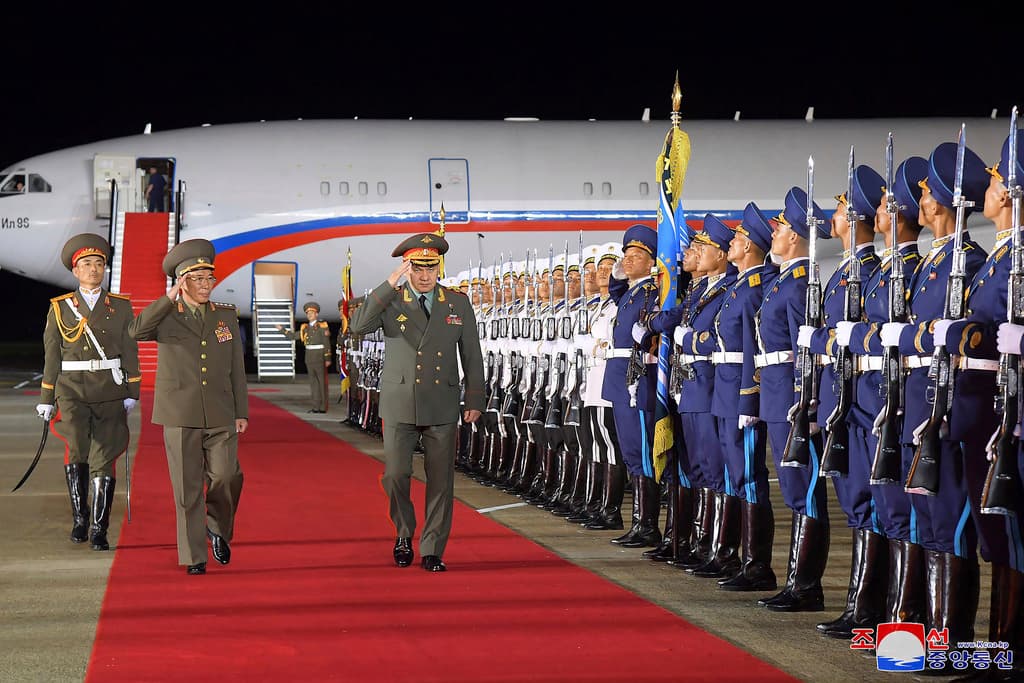Russia Stands With North Korea, Communist China as New Cold War Takes Shape
Sergei Shoigu’s trip to Pyongyang comes as the defense chief struggles to maintain control over the Russian army’s generals in the aftermath of an internal insurrection. He is there to display Russian solidarity, but he also arrives with a shopping list.

As battle lines are drawn for the 21st century’s version of a cold war, Russia has dispatched its defense minister, Sergei Shoigu, to Pyongyang, where the North Korean regime is celebrating an anniversary of what it and Communist China consider the most important victory of the Cold War.
The Kim regime is marking the 70th anniversary since the end of the 1950-53 Korean War. In a military parade on Thursday, new arms are expected to be displayed to show off the impoverished country’s emphasis on weapons development. A Chinese delegation is at hand to boast of what the two communist regimes deem a “glorious victory” over the Free World.
Meanwhile a hot battle is raging in Ukraine between an American-led alliance and an axis of authoritarian regimes. The axis, including the communist regimes of China and North Korea, the Islamic Republic of Iran, and Moscow, is increasingly all-in on that war, arming Russian troops and pitching in with financial, diplomatic, and other aid.
Mr. Shoigu’s trip to Pyongyang comes as the defense chief struggles to maintain control over the Russian army’s generals in the aftermath of an internal insurrection. He is there to display Russian solidarity, but he also arrives with a shopping list. Most prominently, Russia needs artillery munitions, which are emerging as a crucial commodity craved by both sides of the Ukraine war.
“In the bloody battles of 1950-1953, the Korean People’s Army, under the command of Comrade Kim Il-sung, achieved a historic victory over a strong and cruel enemy,” Mr. Shoigu said Wednesday at Pyongyang. “I am convinced that our talks today will help strengthen cooperation between our defense ministries.”
Officials at Moscow and Pyongyang have denied Washington’s assertions that Russia is purchasing arms from North Korea. Yet, “you don’t send your defense minister just for symbolism,” a Russia watcher at the Foundation for Defense of Democracies, John Hardie, tells the Sun.
Mr. Hardie notes that the Russian delegation at Pyongyang includes the deputy defense minister for armaments, Alexei Krivoruchko, who is responsible for managing procurement and development of weapons and military equipment. “His attendance is an indication that Moscow is looking for materiel from North Korea, such as artillery shells,” he says.
In prominent military parades like Thursday’s, North Korea habitually displays new war tools. One such weapon could be a new drone, spotted by satellite image last month. It boasts a larger wingspan, 115 feet, than has been seen before on Korean drones. Yet, Russia now appears to be building Iranian drones on its own soil, as it tightens its arms deals with Tehran.
While drones and other futuristic weapons gain prominence on the European battlefield, the Ukrainian war seemingly is being fought predominantly by means that have won military clashes since World War I, such as artillery. As the Russian military struggles to defend its occupation lines during the current Ukrainian counter-offensive, exchanges of artillery fire could well determine victory or defeat.
Explaining his reasons for arming Kyiv with cluster munitions, President Biden let slip recently that America is “running out” of 155mm Howitzer munitions to send to Ukraine. As the Pentagon amps up production, America will furnish Kyiv with cluster munitions so as to “allow for this transition period while we get more 155 weapons, these shells, for the Ukrainians,” Mr. Biden told CNN.
America now produces 20,000 155mm shells a month, compared with 14,000 a month before the war, according to the secretary of the Army, Christine Wormuth. Yet, Ukraine now reportedly uses some 70,000 Howitzer rounds a month, and America isn’t expected to produce that amount until 2025. In the meantime, Washlngton is hoping that other NATO allies will be able to pitch in.
Although no similarly reliable data is available on the Russian side, it is clear that Moscow too is lagging in its artillery battlefield needs. Hence Mr. Shoigu’s appearance at Pyongyang, where goose-stepping North Korean soldiers greeted the Russian guest Tuesday night.
Pyongyang also feted a delegation from its most important benefactor, Communist China, which was headed by a politburo member, Li Hongzhong. In Beijing’s mythology, the Korean War has been elevated to symbolize the heroics of Chinese soldiers and the victory of a small army over the American Goliath.
“In the light of China’s aggressions today, the United States must understand how China is using the Korean War’s legacy as a form of political preparation for wars to come,” the chairman of the House select committee on China, Mike Gallagher, writes this week.
Communist China is now the top player in the anti-American axis. Yet, as can be gleaned from the Thursday parade at Pyongyang, the new cold war is shaping up to be as globe-girding as its predecessor. America can hardly afford to ignore battles against axis members in Ukraine, the Mideast, or Taiwan. They are all part of the same war.

